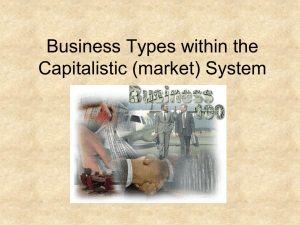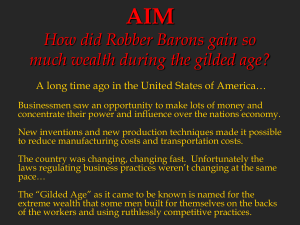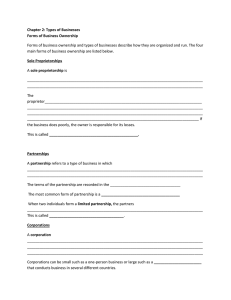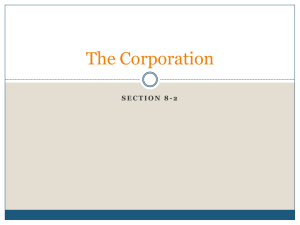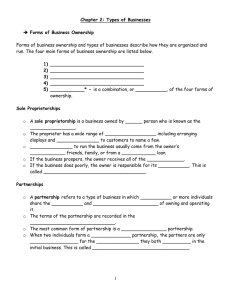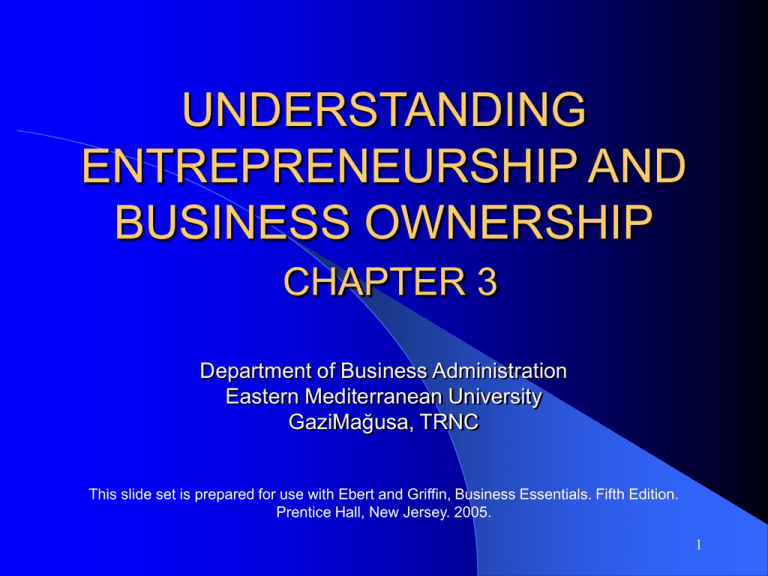
UNDERSTANDING
ENTREPRENEURSHIP AND
BUSINESS OWNERSHIP
CHAPTER 3
Department of Business Administration
Eastern Mediterranean University
GaziMağusa, TRNC
This slide set is prepared for use with Ebert and Griffin, Business Essentials. Fifth Edition.
Prentice Hall, New Jersey. 2005.
1
TOPICS SUMMARY
What is A Small Business?
Entrepreneurship
Starting and Operating the Small
Business
Franchising
Success and Failure in Small Business
Noncorporate Business Ownership
Corporations
2
WHAT IS A SMALL BUSINESS?
Small Business -- a company that is
independently owned and operated, that
is not dominant in its field, and that
meets certain criteria for number of
employees or annual sales revenue.
In the U.S., Department of Commerce
defines a company as small business if
it has fewer than 500 employees.
3
WHAT IS A SMALL BUSINESS?
The Small Business Administration
(SBA) regards some companies with
1500 employees as “small”. The SBA
uses two factors in its definition:
– number of employees
– total annual sales
4
WHAT IS A SMALL BUSINESS?
In Turkey, companies with fewer than 50
employees are classified as small
businesses. Companies with 50 - 199
employees are called medium-sized
businesses.(KOS -- Küçük ve Orta
Ölçekli Sanayi “Small and Medium Size
Enterprises - SME ) Look at link
KOSGEB (Küçük ve Orta Ölçekli Sanayi
Geliştirme ve Destekleme İdaresi
Başkanlığı) for material on SME’s in
5
Turkey.
WHAT IS A SMALL BUSINESS?
Governments in many countries play a
significant role in the formation and
operation of small businesses.
– importance to the overall economy
– provider of jobs
– introduce new products and services
(innovation)
6
WHAT IS A SMALL BUSINESS?
Importance of Small Business in A
Country’s Economy.
In Turkey
– Small and Medium Industrial Enterprises
account for 99.5% of all manufacturing
industrial enterprises.
– Small and medium Industry Enterprises
have a 61.1% share within total
employment in the manufacturing industry.
– As regards value added created, the share
of Small and Medium Industry Enterprises
7
is 27.3%.
WHAT IS A SMALL BUSINESS?
Why is small business so important to
the economy? Let’s look at its
contribution to the economy.
– Job Creation
Many jobs are created by small businesses
than big business. Small business especially in some industries - is an
important source of new jobs.
Example: Dell Computer Company started
with one full-time and two part-time
employees. It now has around 10,000
8
employees.
WHAT IS A SMALL BUSINESS?
– Innovation
Major innovations are as likely to come
from small businesses (or individuals) as
from big businesses. Small businesses (or
individuals invented the
PC, stainless steel razor blade, transistor radio,
the photocopy machine, the jet engine, and the
self developing photograph.
Some innovation stories follow......
9
The Story of Apple Computer
Steven Jobs, with Apple cofounder Steve Wozniak,
built the first Apple computer in his parents’ garage.
Apple Computer went on to become the fastestgrowing company in American history. In 1985, after
developing the original Apple Macintosh, Jobs
resigned to form NeXT, Inc. His innovative designs
have proven technologically superior but prohibitively
expensive and are often considered to be too far
ahead of their time.
REUTERS/THE BETTMANN ARCHIVE
– "Steven Jobs," Microsoft® Encarta® Encyclopedia
99. © 1993-1998 Microsoft Corporation. All rights
reserved.
10
The Story of the Safety Blade
Razors made of substances other than steel have been
in use since ancient times. Straight razors with open
steel blades, now used chiefly by barbers, were
common before the 20th century. A new era in shaving
began in 1903, when the safety razor with disposable
blades was introduced by the American inventor King
Camp Gillette. The thin, small blade was enclosed by
the razor, thus guarding the skin against deep cuts.
Plastic disposable razors and razors with replaceable
blades are in common use today.
"Razor," Microsoft® Encarta® Encyclopedia 99. © 1993-1998
Microsoft Corporation. All rights reserved.
11
The Story of the Polaroid Camera
Land, Edwin Herbert (1909-91), American
physicist and inventor, born in Bridgeport,
Connecticut. While a freshman at Harvard
University in 1926, he became interested in
polarized light (light oriented in a plane with
respect to the source). Taking a leave of
absence, he developed a new kind of polarizer,
which he called Polaroid, by aligning and
embedding crystals in a plastic sheet. Land
returned to Harvard at the age of 19 but left
again in his senior year to found a laboratory
nearby. Joined by other young scientists, he
applied the polarizing principle to light filters,
optical devices, and motion picture processes.
12
The Story of the Polaroid Camera
In 1937 the group became the Polaroid
Corporation with Land as president and head of
research. During World War II the corporation
turned to military tasks, inventing infrared
filters, dark-adaptation goggles, and target
finders. In the late 1940s it introduced the first
model of its most successful product, the selfdeveloping Polaroid Land camera; it also put
out a microscope for viewing living cells in
natural color. For his contributions to the fields
of polarized light, photography, and color
perception, Land received numerous awards
and honorary degrees.
"Land, Edwin Herbert," Microsoft® Encarta®
Encyclopedia 99. © 1993-1998 Microsoft
Corporation. All rights reserved.
13
WHAT IS A SMALL BUSINESS?
– Importance of Small Business to Big
Business
most products made by big manufactureres are
sold to consumers by small businesses
– Think of all the products that are made by large
companies which you buy from small businesses
small businesses provide big businesses with
many of the services, supplies, and raw
materials they need
14
POPULAR AREAS OF SMALL
BUSINESS ENTERPRISE
The seven major small business
industry groups are
1.
2.
3.
4.
5.
6.
7.
services (hizmetler)
retailing (perakende)
construction
financial and insurance
wholesaling (toptantıcılık)
transportation
manufacturing (imalat)
Each group differs in its requirements for
employees, money, materials, and machines. Also
remember that manufacturing businesses are the
hardest to start and service businesses the easiest.15
POPULAR AREAS OF SMALL
BUSINESS ENTERPRISE
1. Services:
Service businesses require few
resources, therefore they are relatively
easy to establish
Services appeal to the talent for
innovation
– motorcycle-courier service in İstanbul
– some banks offering all kinds of services
to holders of their credit cards
– companies offering “dog walking” service16
in İstanbul and Ankara
POPULAR AREAS OF SMALL
BUSINESS ENTERPRISE
2. Retailing:
A retail business sells products
manufactured by other firms directly to
consumers. (perakendeci)
There are thousands of retail shops
that sell everything from shoes to cars.
Some retail businesses concentrate on
being “specialty” shops focusing on
narrow market segments.
– Pickles shop (turşucu); Mado (ice-
cream); slipper shop (terlikçi); etc.
17
POPULAR AREAS OF SMALL
BUSINESS ENTERPRISE
3. Wholesaling:
A wholesale business buys products
from manufacturers or other producers
and then sell them to retailers.
(toptancı)
They buy goods in bulk and store them
in quantities and places convenient for
retailers.
They need fewer employees than
18
manufacturers or retailers.
POPULAR AREAS OF SMALL
BUSINESS ENTERPRISE
4. Manufacturing:
Manufacturing is more suitable for big
business due to heavy investment
requirements. (machinery, energy,
materials, workforce, etc.)
This does not mean that there are no
small and medium sized
manufacturing businesses. There are
many SME’s that produce lots of
products for other manufacturers and
19
also for consumers.
ENTREPRENEURSHIP
We already know who an entrepreneur
is from earlier discussions. Although
many small business people like to think
of themselves as entrepreneurs, this is
not always the case.
An individual who starts a small
business with no future plans to grow
and expand, is not really an
entrepreneur in a true sense.
20
ENTREPRENEURSHIP
Entrepreneurial Characteristics
– resourcefulness
– concern for good, often personal, customer
relations
– strong desire to be their own bosses
– able to handle ambiguity
– enjoy taking risks and hard work
– strong need for personal freedom and
opportunity
İbrahim Özer of Özer Elektronik (ESCORT)
Jeff Bezos of Amazon Online Bookstore
21
– selected 1999 Person of the Year by TIME Magazine
STARTING AND OPERATING A
SMALL BUSINESS
How should one get into business?
– buy an existing business?
– build from the ground up? In other words,
start one’s own company from scratch.
– how about financing (finding enough
money) the new business?
– how about seeking expert advice from
others (friends, consultants (danışmanlar),
others?)
22
STARTING AND OPERATING A
SMALL BUSINESS
Buying an Existing Business
– reduced risks (known product and system
for producing it)
– no need to go through the process of
building a reputation, establishing clientele,
hiring and training personnel
– obtaining financing is easier because of
past successful operation of the business
– established working relationships with
suppliers, lenders, and the community
23
STARTING AND OPERATING A
SMALL BUSINESS
Starting from Scratch (start your own
company)
– more risky but flexible
– most difficult
– formation formalities may take a long time
– a very common way of going into business
both in Turkey and abroad.
Just consider the computer hardware and
software business---many new businesses are
formed
24
STARTING AND OPERATING A
SMALL BUSINESS
– Before starting a business, entrepreneurs
must study their markets and answer the
following questions:
who are my customers?
where are they?
at what price will they buy my product?
in what quantities will they buy?
who are my competitors?
how will my product differ from that of my
competitors?
How will the above questions be
answered? Next slide..
25
STARTING AND OPERATING A
SMALL BUSINESS
– Sources of information:
the best way to get information about a market
is to work in it before going into business in it
quick scan of Yellow Pages (phone book) or
advertisements in trade journals will help reveal
potential competitors
in Turkey, Chambers of Commerce (Ticaret
Odaları), Chambers of Industry (Sanayi
Odaları), and Union of Chambers of
Commerce, Industry, Maritime Trade and
Commodity Exchanges of Turkey (TOBB) are
excellent sources of information
26
STARTING AND OPERATING A
SMALL BUSINESS
For Istanbul Chamber of Industry click
For TOBB click
For Ankara Chamber of Industry click
http://www.aso.org.tr
27
STARTING AND OPERATING A
SMALL BUSINESS
For an excellent source on business in
Turkey click
For general information about web sites
in Turkey click
www.arabul.com
28
STARTING AND OPERATING A
SMALL BUSINESS
Another good source for business
information is “Turkey On-Line Yellow
Pages”
29
FRANCHISING
One way to avoid some management
headaches associated with starting a
business is to invest in a franchise
– What is a franchise? A business arrangement
in which an individual obtains rights from a
larger company to sell a well-known product
or service.
– Franchisee--person or group to whom a
corporation grants an exclusive right to the
use of its name in a certain territory. (initial
fee plus monthly payments based on sales)
– Franchiser -- corporation that grants a
30
franchise to an individual or group
FRANCHISING
Advantages of Franchising
– Franchiser builds a strong foundation for
his company
expanded business and profits
regular income from franchisees
– Franchisee can take advantage of a
proven business and its systems
low risk; proven business
name recognition, mass advertising benefits
lack of money problems solved (start-up money
given by franchiser)
Training, technical assistance and managerial
advice given by the franchiser
31
FRANCHISING
Disadvantages of Franchising
– it is not the cheapest way to go into
business
– royalty must be paid (monthly/yearly)
– little independence on the part of the
franchisee
– franchisee must buy from the franchiser at
whatever price it charges
– important decisions can be made without
consulting the franchisees
– possibility of fraud (hile)
32
– the franchiser may go out of business
SUCCESS AND FAILURE IN
SMALL BUSINESS
While some small businesses become
successful and eventually grow into
large corporations, there are many
small businesses that fail.
Trends in Small Business Start-Ups
Many new businesses are started each
year. There are several factors for this
trend. These are discussed in the next
few slides....
33
FAILURE AND SUCCESS IN
SMALL BUSINESS
– Crossovers from big business
People leave large companies, form their
own businesses and put their experience
and know-how to work for themselves.
– Opportunities for Minorities and Women
This is especially true for the U.S. Not a
significant trend in Turkey, Cyprus and
many other countries.
– Global opportunities
Many entrepreneurs are finding new
opportunities in foreign countries and
markets
34
FAILURE AND SUCCESS IN
SMALL BUSINESS
– Better Survival Rates
In the U.S., the survival rate (yaşama
oranı) has been increasing over the years.
This encourages entrepreneurs to
establish small and medium sized
businesses. In Turkey and many other
developing countries, the same claim can
not be made due to
– economic instability
– high inflation or deflation
– high interest rates
– unstable political environment
– greater uncertainty about the future
35
VENTURE CAPITAL
VENTURE CAPITAL IST
RISK SERMAYESI
36
FAILURE AND SUCCESS IN
SMALL BUSINESS
Reasons for Failure:
– managerial incompetence or inexperience
– neglect
– weak control systems
– insufficient capital
Reasons for Success:
– hard work, drive and dedication
– market demand for products or services
being provided
– managerial competence
– luck
37
NONCORPORATE BUSINESS
OWNERSHIP
Types of business organizations are:
1. Sole proprietorship (şahıs işletmesi)
2. Partnership (ortaklık)
3. Corporation (anonim şirket)
A critical decision -- it affects
managerial and financial issues
38
SOLE PROPRIETORSHIP
(Şahıs İşletmesi)
business is owned and operated by a
single individual who is responsible for
all of its debts
many small businesses are in this
category
– dry cleaners, grocers, meat stores, florists,
barber shops, beauty parlors, etc.
many people may be employed
39
SOLE PROPRIETORSHIP
(Şahıs İşletmesi)
Advantages of Sole Proprietorships
– freedom -- responsible only to themselves
– privacy -- no need to report information to
shareholders or partners
– simple to form (need a license only)
– “work for yourself”
– easy to dissolve (feshetmek)
– low start-up costs (little money is needed)
– owner keeps all the profits; profits are taxed at
personal income rates
40
SOLE PROPRIETORSHIP
(Şahıs İşletmesi)
Disadvantages of Sole Proprietorships
– unlimited liability : owners are responsible for
paying off all debts of a business (sınırsız
sorumluluk)
– lack of continuity : if the owner dies, the business
is legally dissolved (NOTE: This may change from
country to country)
– small business, therefore limited financial
resources
– business depends upon owner’s talents (yetenek)
and skills (beceri)
– hard to borrow money; may have to pay higher
interest rates for borrowing
41
PARTNERSHIPS
(Ortaklıklar)
Most common type of partnership is called
general partnership (kollektif şirket)
– it is an extension of sole proprietorship; two or
more partners
– partners share in both the operation and in the
financial responsibility for its debts
– In the Turkish Commercial Code “Türk Ticaret
Yasası” these are referred to as Ticaret Şirketleri
LINK (In Turkish) : Ministry of Industry & Trade
42
PARTNERSHIPS
(Ortaklıklar)
Advantages of Partnerships
– ability to grow with the addition of new
talent and money
– easier to borrow money compared to sole
proprietorships
– easy to form (as compared to corporations)
– superior to sole proprietorships in terms of
resources (due to partners)
43
PARTNERSHIPS
(Ortaklıklar)
Disadvantages of Partnerships
unlimited liability of general partners
potential for interpersonal problems and
disagreements
“unproductive partners” problem (ense
yapan ortaklar sorunu)
rivalry among partners may damage the
business
more difficult to obtain loans as
compared to corporations
lack of continuity (when one partner dies
or leaves, the original partnership
44
dissolves
CORPORATIONS
(Anonim Şirketler)
Corporation : A business that is legally
considered an entity separate from its
owners and is liable (sorumlu) for its
own debts; owners’ liability extends to
the limits of their investments. (Anonim
Şirket)
45
CORPORATIONS
(Anonim Şirketler)
What is a “corporate entity” ?
– It is an artificial being separate from the owners in the
eyes of the law
– It is a “legal person” (tüzel kişilik, hükmi şahsiyet)
As a corporate entity, corporations can do the
following:
– sue and be sued (davacı veya davalı olabilir)
– buy, hold, and sell property
– make and sell products to customers
– commit crimes (suç işlemek) and be tried and
punished for them
46
CORPORATIONS
(Anonim Şirketler)
Advantages of Corporations
– limited liability of owners (sınırlı sorumluluk)
– continuity (süreklilik): unlimited life span
unlimited life span allows for long range plans for
recruiting, training and retaining talented employees
– can raise money more easily
sell more stock
get loans from banks and other financial institutions
– successful in bringing together money,
resources, and talent
47
CORPORATIONS
(Anonim Şirketler)
Disadvantages of Corporations
– ease of transfer of ownership
– cost of incorporation (şirketin kurulması)
to set up a corporation requires a lot of work and money,
especially if stocks are being offered to the public
– required by law to publish information about
finances and operations (especially for public
corporations)
Companies traded at İMKB (İstanbul Stock Exchange)
have to disclose balance sheets every 3 months
– heavily regulated (many do’s and don’ts by the
government and laws)
– double taxation (çifte vergilendirme)
corporate income tax paid by the corporation
personal income tax paid by stokholders on the
dividends (kar payı, temettü) that they receive
48
CORPORATIONS
(Anonim Şirketler)
There are basically two types of
corporations:
1. Public Corporations (Halka Açık Anonim
Şirket)
2. Private Corporations (Halka Açık Olmayan
Anonim Şirket)
Now let us see each type....
49
CORPORATIONS
(Anonim Şirketler)
1. Public Corporation (Halka Açık
Anonim Şirket)
Corporation whose stock (shares)
(hisse senedi) is widely held and
available for sale to the general public.
The shares are actively traded on the
open market.
Examples: Arçelik, General Motors, Intel
Corp. etc
50
CORPORATIONS
(Anonim Şirketler)
2. Private Corporations (Halka Açık
Olmayan Anonim Şirket)
–
Sometimes called “closely held
corporation”
Corporation whose stock is held by
only a few people and is not available
for sale to the general public. The
stockholders (shareholders) may be
one person, a family, a management
group, or the firm’s employees.
51
MANAGING A CORPORATION
Corporate Governance (Anonim
Şirketin Yönetilmesi)
Three distinct bodies or groups are
responsible for the governance of a
corporation:
1. Stockholders (hissedarlar; hisse
sahipleri)
2. Board of Directors (Yönetim Kurulu)
3. Corporate Officers (Şirket Üst
Yönetimi)
Let us look at each one more closely....52
MANAGING A CORPORATION
1. Stockholders (hissedarlar; pay
sahipleri)
Stockholders or shareholders are the
owners of shares of stock (hisse; pay)
in a corporation. They are the owners
of the corporation.
–
–
they get dividends (kardan pay; temettü)
in return for their investment in the
company
they select the Board of Directors
53
MANAGING A CORPORATION
Two types of stock
1. Common Stock -- stock that pays
dividends and guarantees corporate
voting rights but offers last claims over
assets (şirketin varlıkları)
2. Preferred stock -- Stock that guarantees
its holders fixed dividends and priority
claims over assets but no corporate
voting rights. Preferred stock owners
have priority over common stockholders
when dividends are distributed.
54
MANAGING A CORPORATION
Proxy -- authorization given by a
shareholder for someone else to vote his or
her shares (vekaletname ile oy verme)
2. Board of Directors -- top governing
body of a corporation
– reports to shareholders
– delegates power to officers (üst yönetim)
to run its day-to-day operations
– is responsible for the general
management and assets of the
corporation
continued....
55
MANAGING A CORPORATION
– prepares the annual report (yıllık çalışma
raporu) and presents it to the stockholders
– top policy-making body on dividends, major
spending
56
MANAGING A CORPORATION
3.
Corporate Officers
Appointed by the Board of Directors
to run the company. These are the top
managers (üst yönetim).
– Chief Executive Officer (CEO):
Top manager hired by the board of
directors to run the corporation (Murahhas
Üye)
– Other officers : president (genel müdür),
vice presidents (genel müdür yardımcıları)
57
CORPORATIONS
(Anonim Şirketler)
Special Issues in Corporate Ownership
– Joint Ventures : collaboration between two
or more organizations on an enterprise or
project. Usually a new company is formed
(Ortak Girişim)
– Strategic Alliances : two or more
organizations collaborate on a project for
mutual gain
SONY and Philips collaborated (worked
together) to develop the compact disc (CD) in
the 1980’s
58
CORPORATIONS
(Anonim Şirketler)
– Employee Stock Ownership Plans (ESOP)
An arrangement in which a corporation
enables its own employees to receive
stocks of the corporation and thus become
owners of the corporation. (Çalışanların
Hissedar Yapılması Planı)
– Institutional Ownership
Large organizations or companies that buy
large blocks of stocks of other corporations
(Kurumsal Yatırımcılar)
59
CORPORATIONS
(Anonim Şirketler)
– Merger (Birleşme) : the union of two
corporations to form a new corporation.
horizontal merger : two companies in the same
industry combine to form a new corporation
vertical merger : when a supplier company
combines with a buyer company to form a new
corporation
conglomerate merger : when two unrelated (in
different industries and no buyer-seller
relationship) companies combine to form a new
corporation
60
CORPORATIONS
(Anonim Şirketler)
– Acquisition (Satınalma) : the purchase of
one company by another
– Divestitures and Spin-Offs:
Divestiture - strategy whereby a firm sells one
or more of its business units (elden çıkarmak)
Spin-Off - strategy of setting up one or more
corporate units as new, independent
corporations (anonim şirketin bir birimini yeni
bir şirket haline getirmek)
61

